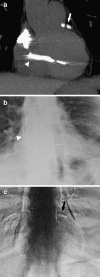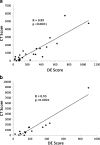Assessment of coronary artery calcium using dual-energy subtraction digital radiography
- PMID: 21557030
- PMCID: PMC3264713
- DOI: 10.1007/s10278-011-9385-y
Assessment of coronary artery calcium using dual-energy subtraction digital radiography
Abstract
Cardiovascular disease is the leading cause of global mortality, yet its early detection remains a vexing problem of modern medicine. Although the computed tomography (CT) calcium score predicts cardiovascular risk, relatively high cost ($250-400) and radiation dose (1-3 mSv) limit its universal utility as a screening tool. Dual-energy digital subtraction radiography (DE; <$60, 0.07 mSv) enables detection of calcified structures with high sensitivity. In this pilot study, we examined DE radiography's ability to quantify coronary artery calcification (CAC). We identified 25 patients who underwent non-contrast CT and DE chest imaging performed within 12 months using documented CAC as the major inclusion criteria. A DE calcium score was developed based on pixel intensity multiplied by the area of the calcified plaque. DE scores were plotted against CT scores. Subsequently, a validation cohort of 14 additional patients was independently evaluated to confirm the accuracy and precision of CAC quantification, yielding a total of 39 subjects. Among all subjects (n = 39), the DE score demonstrated a correlation coefficient of 0.87 (p < 0.0001) when compared with the CT score. For the 13 patients with CT scores of <400, the correlation coefficient was -0.26. For the 26 patients with CT scores of ≥400, the correlation coefficient yielded 0.86. This pilot study demonstrates the feasibility of DE radiography to identify patients at the highest cardiovascular risk. DE radiography's accuracy at lower scores remains unclear. Further evaluation of DE radiography as an inexpensive and low-radiation imaging tool to diagnose cardiovascular disease appears warranted.
Figures



Similar articles
-
Estimating the accuracy of dual energy chest radiography for coronary calcium detection with lateral or anteroposterior orientations.Med Phys. 2022 Sep;49(9):5763-5772. doi: 10.1002/mp.15855. Epub 2022 Jul 22. Med Phys. 2022. PMID: 35848231 Free PMC article.
-
Feasibility of coronary artery calcium scoring on virtual unenhanced images derived from single-source fast kVp-switching dual-energy coronary CT angiography.J Cardiovasc Comput Tomogr. 2014 Sep-Oct;8(5):391-400. doi: 10.1016/j.jcct.2014.08.005. Epub 2014 Aug 28. J Cardiovasc Comput Tomogr. 2014. PMID: 25301045 Clinical Trial.
-
[Image quality of CT angiography of coronary arteries depending on the degree of coronary calcification using a dual source CT scanner].Rofo. 2009 Sep;181(9):863-9. doi: 10.1055/s-0028-1109489. Epub 2009 Aug 12. Rofo. 2009. PMID: 19676015 German.
-
Estimation of cardiovascular risk on routine chest CT: Ordinal coronary artery calcium scoring as an accurate predictor of Agatston score ranges.J Cardiovasc Comput Tomogr. 2017 Jan-Feb;11(1):8-15. doi: 10.1016/j.jcct.2016.10.001. Epub 2016 Oct 5. J Cardiovasc Comput Tomogr. 2017. PMID: 27743881
-
Extracoronary Thoracic and Coronary Artery Calcifications on Chest CT for Lung Cancer Screening: Association with Established Cardiovascular Risk Factors - The "CT-Risk" Trial.Acad Radiol. 2015 Jul;22(7):880-9. doi: 10.1016/j.acra.2015.03.005. Epub 2015 May 7. Acad Radiol. 2015. PMID: 25957500 Review.
Cited by
-
Measuring myofiber orientations from high-frequency ultrasound images using multiscale decompositions.Phys Med Biol. 2014 Jul 21;59(14):3907-24. doi: 10.1088/0031-9155/59/14/3907. Epub 2014 Jun 24. Phys Med Biol. 2014. PMID: 24957945 Free PMC article.
-
Topological Data Analysis in the Assessment of Coronary Atherosclerosis: A Comprehensive Narrative Review.Mayo Clin Proc Digit Health. 2025 Feb 20;3(2):100199. doi: 10.1016/j.mcpdig.2025.100199. eCollection 2025 Jun. Mayo Clin Proc Digit Health. 2025. PMID: 40568615 Free PMC article. Review.
-
Estimating the accuracy of dual energy chest radiography for coronary calcium detection with lateral or anteroposterior orientations.Med Phys. 2022 Sep;49(9):5763-5772. doi: 10.1002/mp.15855. Epub 2022 Jul 22. Med Phys. 2022. PMID: 35848231 Free PMC article.
-
Dual energy imaging in cardiothoracic pathologies: A primer for radiologists and clinicians.Eur J Radiol Open. 2021 Jan 20;8:100324. doi: 10.1016/j.ejro.2021.100324. eCollection 2021. Eur J Radiol Open. 2021. PMID: 33532519 Free PMC article. Review.
-
Detection of coronary calcifications with dual energy chest X-rays: clinical evaluation.Int J Cardiovasc Imaging. 2021 Mar;37(3):767-774. doi: 10.1007/s10554-020-02072-4. Epub 2020 Oct 28. Int J Cardiovasc Imaging. 2021. PMID: 33113069 Free PMC article.
References
-
- Greenland P, Bonow RO, Brundage BH, et al. ACCF/AHA 2007 clinical expert consensus document on coronary artery calcium scoring by computed tomography in global cardiovascular risk assessment and in evaluation of patients with chest pain: a report of the American College of Cardiology Foundation Clinical Expert Consensus Task Force (ACCF/AHA Writing Committee to Update the 2000 Expert Consensus Document on Electron Beam Computed Tomography) developed in collaboration with the Society of Atherosclerosis Imaging and Prevention and the Society of Cardiovascular Computed Tomography. J Am Coll Cardiol. 2007;49(3):378–402. doi: 10.1016/j.jacc.2006.10.001. - DOI - PubMed
Publication types
MeSH terms
Grants and funding
LinkOut - more resources
Full Text Sources
Medical

